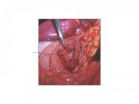(Press-News.org) INDIANAPOLIS -- Researchers at the Indiana University School of Medicine have discovered a highly accurate, noninvasive test to identify benign pancreatic cysts, which could spare patients years of nerve-racking trips to the doctor or potentially dangerous surgery.
The findings are reported in "Vascular Endothelial Growth Factor, a Novel and Highly Accurate Pancreatic Fluid Biomarker for Serous Pancreatic Cysts" online in the Journal of the American College of Surgeons.
The test, which analyzes fluid from pancreatic cysts, can identify a common type of benign cyst that can't be differentiated by imaging alone from cysts that may progress to pancreatic cancer.
Pancreatic cyst fluid is tested for a biomarker, a specific isoform of vascular endothelial growth factor A, or VEGF-A. Pancreatic cyst fluid is often obtained in patients with pancreatic cysts as a part of standard testing during endoscopy. High levels of VEGF-A indicate with 99 percent accuracy that the cyst will not become malignant, the researchers found after analyzing the results of 87 patients.
First author Michele T. Yip-Schneider, Ph.D., associate research professor of surgery, and senior author C. Max Schmidt, M.D., Ph.D., MBA, professor of surgery, biochemistry and molecular biology, report this is the first cyst fluid protein biomarker that can differentiate serous cystic neoplasms, a benign type of cystic lesion, from all other cancerous or precancerous cystic lesions without surgery.
Pancreatic cancer is one of the deadliest cancers in part because it is frequently diagnosed late and treatment options are somewhat limited. According to the National Cancer Institute, about 45,220 people will be diagnosed this year with pancreatic cancer and about 38,460 will die from the disease.
Treatments may include chemotherapy, radiation and surgery, but few patients are cured.
"Only 15 percent of pancreatic cancer patients will benefit from surgery, and of those, only about 20 percent will survive five years," said Dr. Schmidt, who is a researcher with the Indiana University Melvin and Bren Simon Cancer Center and director of the IU Health Pancreatic Cyst and Cancer Early Detection Center.
Complications from pancreatic surgery are common and can be life threatening, so sparing a patient unnecessary surgery is important, Dr. Schmidt said.
"As scientists, we have tried to figure out which cystic lesions are benign, which are pre-cancerous and which are malignant," Dr. Yip-Schneider said. "Although pancreatic cysts are best seen on pancreatic MRI-MRCP, making a diagnosis of which type of cyst and how likely cancer will develop is not usually possible through imaging alone."
Surgery is not the panacea that patients frequently hope for, and the majority of pancreatic cancer patients aren't even eligible due to the advanced stage of the disease at presentation.
Pancreatic cysts and cancer are becoming more common in the American population. It is unclear why, but pancreatic cancer is clearly associated with obesity, smoking and a family history of pancreatic cancer.
Today, about 3 percent of the U.S. population has pancreatic cysts, although many are asymptomatic and go undiagnosed. Most of these cysts are pre-cancerous, but some are completely benign while others are cancerous. Patients go through extensive follow-up medical visits, invasive biopsies and sometimes unnecessary surgery to determine the true nature of their pancreatic cyst. The novel marker VEGF-A can completely eliminate the need for this extensive follow-up and potential harm for patients with unrecognized benign cysts, the researchers said.
"Many of my patients when initially told they have pancreatic cysts are very fearful and ask for surgical removal of the cyst or the entire pancreas before they even learn their options," Dr. Schmidt said. "Now, physicians will have an outpatient procedure to offer that can take some of the guesswork out of the equation."
INFORMATION:
A short video describing this research can be found at http://youtu.be/NGLh6rjOPvs.
Game changer: Biomarker identified for noncancerous pancreatic cysts
2014-02-11
ELSE PRESS RELEASES FROM THIS DATE:
New target isolated for leukemia drug development
2014-02-11
SAN ANTONIO (February 11, 2014) – There are potentially effective treatments for acute myeloid leukemia (AML), but they only work in 20 to 40 percent of cases. In a paper published today in Leukemia, a Nature journal, a UT Health Science Center researcher has pinpointed a protein that could play a key, previously unknown role in the development of pediatric AML — promising new information in the quest to treat and cure childhood leukemias.
AML starts at the point when cells mature into different kinds of blood cells. In AML, the cancerous cells grow and proliferate in ...
No clowning around: Juggling sheds light on how we run
2014-02-11
Juggling may seem like mere entertainment, but a study led by Johns Hopkins engineers used this circus skill to gather critical clues about how vision and the sense of touch help control the way humans and animals move their limbs in a repetitive way, such as in running. The findings eventually may aid in the treatment of people with neurological diseases and could lead to prosthetic limbs and robots that move more efficiently.
The study was published online recently by the Journal of Neurophysiology and will be the cover article in the journal's March 2014 print edition.
In ...
EU rules are denying children latest cancer drugs
2014-02-11
Children with cancer are being denied new, potentially life-saving drugs, because EU rules are allowing companies to trial some drugs only in adults, leading cancer experts warn today.
Changes to how EU rules are implemented could allow children access to a goldmine of potential cancer drugs which have currently only been tested in adults – by making it more difficult for pharma companies to avoid testing them in under-18s too.
Under the current system, pharma companies often gain exemptions from carrying out expensive testing of cancer drugs in patients under the age ...
Heart attack research discovers new treatment target
2014-02-11
New Orleans, LA – Research led by David Lefer, PhD, Professor and Director of the Cardiovascular Center of Excellence at LSU Health Sciences Center New Orleans School of Medicine, demonstrates for the first time cross-talk between two protective signaling molecules during a heart attack. By providing new and important information about the mechanisms involved in heart attacks and organ transplantation, the research identifies a potential new treatment target for heart disease. The paper will be published in Proceedings of the National Academy of Sciences (PNAS) Online Early ...
Point-of-care ultrasound for suspected appendicitis in kids proves accurate
2014-02-11
New York, NY – Using portable ultrasound as a first-line imaging study in kids with suspected appendicitis helps reduce emergency room length of stay and reduces the need for CT scans, according to a team of Mount Sinai researchers. Bedside ultrasound, often referred to as point-of-care ultrasonography, has a specificity of about 94%, meaning that it misses few cases, , the Mt. Sinai researchers add. Results from the study are published online February 10 in the peer-reviewed journal Academic Emergency Medicine.
"From an institutional perspective, this is the most common ...
ASTRO and SSO issue consensus guideline on margins for breast-conserving surgery with WBI
2014-02-11
Fairfax, Va., February 10, 2014 – The American Society for Radiation Oncology (ASTRO) and the Society of Surgical Oncology (SSO) are pleased to announce the publication of the consensus guideline on margins for breast-conserving surgery with whole-breast irradiation in stages I and II invasive breast cancer. The guideline document represents an intensive collaboration among experts in the radiation oncology and surgical oncology fields, led by Meena S. Moran, MD, associate professor of the Department of Therapeutic Radiology at Yale School of Medicine in New Haven, Conn., ...
Maps show expected redistribution of global species due to climate change
2014-02-11
As climate change unfolds over the next century, plants and animals will need to adapt or shift locations to follow their ideal climate. A new study provides an innovative global map of where species are likely to succeed or fail in keeping up with a changing climate. The findings appear in the science journal Nature.
As part of a UC Santa Barbara National Center for Ecological Analysis and Synthesis (NCEAS) working group, 18 international researchers analyzed 50 years of sea surface and land temperature data (1960-2009). They also projected temperature changes under ...
Obese children more likely to have complex elbow fractures and further complications
2014-02-11
ROSEMONT, Ill.─Pediatric obesity is currently an epidemic, with the prevalence having quadruped over the last 25 years. Children diagnosed with obesity can be at risk for various long-term health issues and may be putting their musculoskeletal system at risk. According to new research in the February issue of the Journal of Bone and Joint Surgery (JBJS), obese children who sustain a supracondylar humeral (above the elbow) fracture can be expected to have more complex fractures and experience more postoperative complications than children of a normal weight.
"These ...
Giant mass extinction may have been quicker than previously thought
2014-02-11
The largest mass extinction in the history of animal life occurred some 252 million years ago, wiping out more than 96 percent of marine species and 70 percent of life on land — including the largest insects known to have inhabited the Earth. Multiple theories have aimed to explain the cause of what's now known as the end-Permian extinction, including an asteroid impact, massive volcanic eruptions, or a cataclysmic cascade of environmental events. But pinpointing the cause of the extinction requires better measurements of how long the extinction period lasted.
Now researchers ...
High pollutant levels in Guánica Bay 'represent serious toxic threat' to corals
2014-02-11
The pollutants measured in the sediments of Guánica Bay, Puerto Rico, in a new NOAA study were among the highest concentrations of PCBs, chlordane, chromium and nickel ever measured in the history of NOAA's National Status & Trends, a nationwide contaminant monitoring program that began in 1986.
Researchers from the National Ocean Service's National Centers for Coastal Ocean Science (NCCOS) studied the reef's ecology to help establish baseline conditions that coastal managers can use to measure changes resulting from new efforts to manage pollution. Among the items studied ...



